The Acer Predator Triton 500 Laptop Review: Going Thin with GeForce RTX 2080
by Brett Howse on April 25, 2019 8:00 AM ESTDisplay Analysis
Gaming laptops are the one holdout for TN display panels, since they are easier to drive at high refresh rates. But with this current generation of gaming laptops we’ve finally got a glimpse at high-refresh IPS, and it is glorious. Coupled with G-SYNC, the Acer Predator Triton 500 offers both high refresh rates and variable refresh, all without the TN compromise of poor viewing angles and generally worse color reproduction. That’s not to say all gaming laptops with TN displays were inferior, because some of them had very good quality TN displays, but TN just can’t match IPS in these areas.
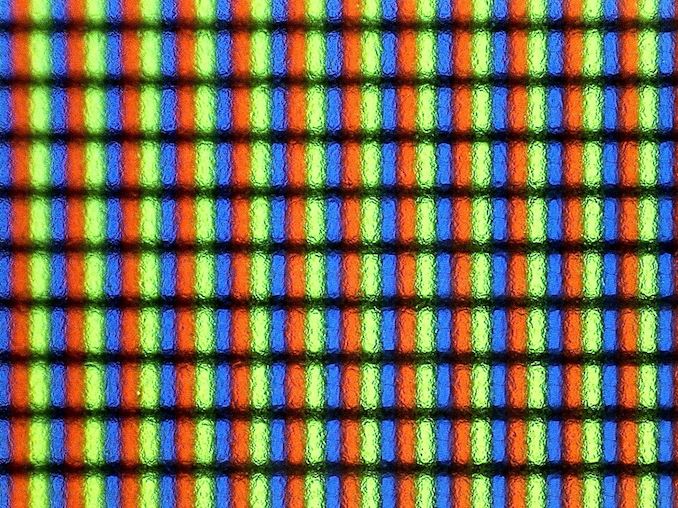 The matte coating makes the pixels blurry
The matte coating makes the pixels blurry
If you’ve not had a chance to game on a high-refresh G-SYNC display, you are really missing out. Everything is so smooth. 60 Hz works fine for desktop applications, but when gaming the difference between 60 Hz and the 144 Hz of this panel is a huge transformation. Acer is, of course, not the only manufacturer to offer this display, but it is definitely a winner for this demographic.
Color accuracy is something we always hope for, but gaming laptops haven’t ever proven themselves caring in this regard, with perhaps the exception of Razer who has done some color calibrating. To see how Acer did, the Triton 500 was run through our display workflow, leveraging SpectraCal’s CalMAN software suite, along with an X-Rite i1Display Pro colorimeter for brightness and contrast readings, and an X-Rite i1Pro2 spectrophotometer for color accuracy results.
Brightness and Contrast
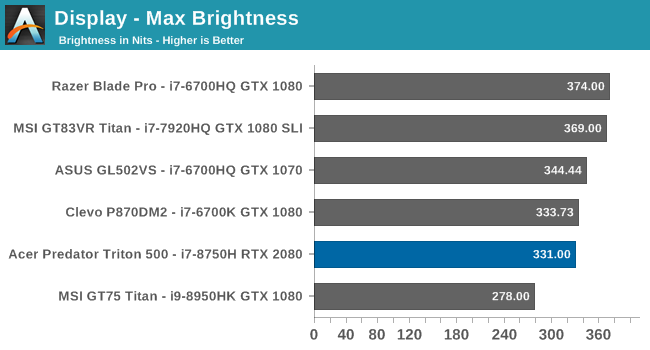
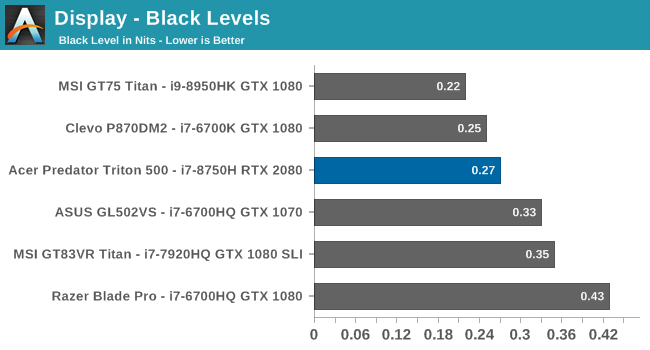
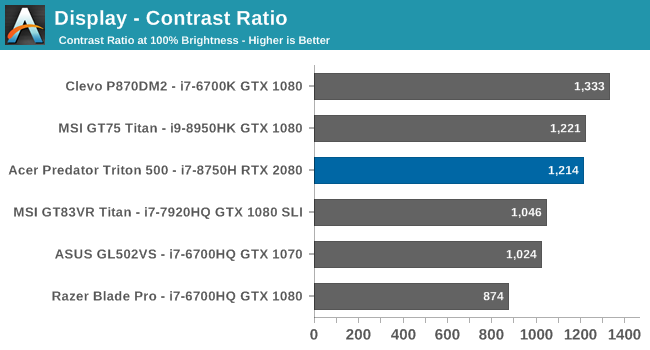
The Triton 500 gets reasonably bright, at 331 nits, considering it’s still a gaming laptop and is likely to be used indoors. That is plenty of brightness for most indoor use, and the matte coating helps minimize glare. The display also offers good contrast, thanks to excellent black levels. The display goes all the way down to 3 nits too, if you want to use it in a very dark room.
Grayscale
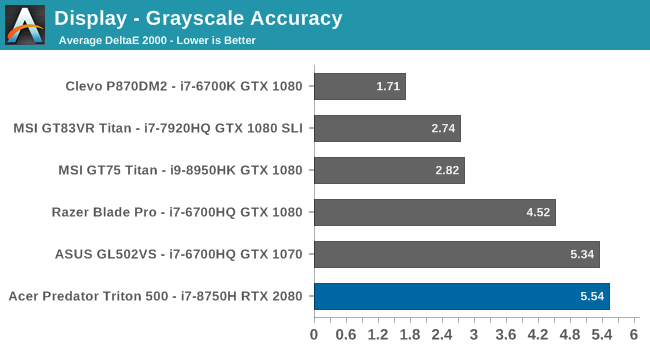
As expected, Acer isn’t calibrating this display at the factory, and the grayscale results are poor. Color balance is off quite a bit, with blue being far too strong at 100% brightness, and red being far too dim. Luckily however, the gamma is very close to the 2.2 power expected for sRGB.
Gamut

Looking at the gamut results, which targets the 100% levels for the primary and secondary colors, you can see how far off the blue result is. It’s actually well past the correct levels for sRGB.
Saturation
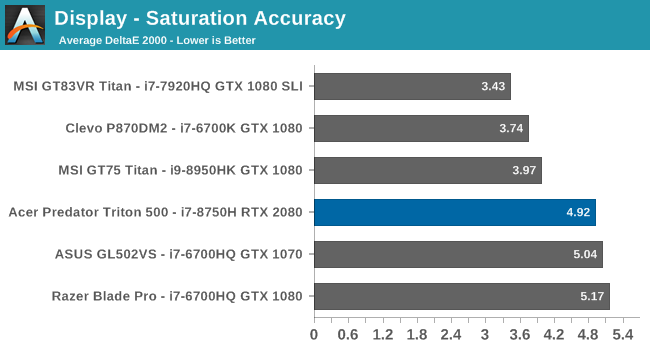
The saturation sweep targets the primary and secondary colors, like gamut, but rather than just hit the 100% levels we test at 4-bit steps to see how it is across the entire range. All of the colors are off, with teal having the most error across 0-100% and the results are pretty typical of an uncalibrated display.
Gretag Macbeth
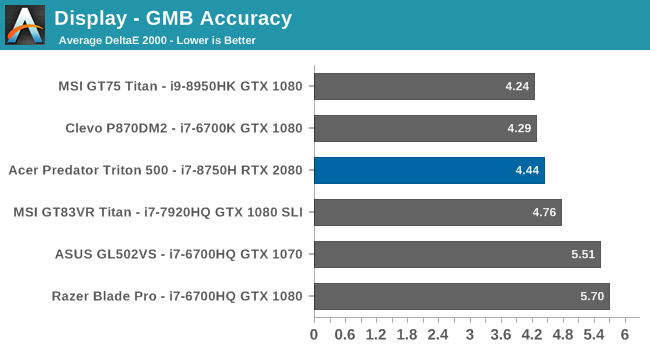
The final test moves outside of the primary and secondary colors, and tests colors across the spectrum, including the important skin tones. Ideally, every color tested would be under the yellow line on the DeltaE 2000 graph, but almost all of them are well over. It’s not a terrible result, but it’s not good either.
Colorchecker
The colorchecker demonstrates a relative result that you can see, rather than just looking at graphs. The bottom color is the target, and the top color is the result. This is relative though because errors in your display will impact the absolute differences, but it still helps to provide a general guide as to what this display looks like. Pretty much all of the colors are significantly different than their target, and the whites are far too blue.
Display conclusion
Acer’s Predator Triton 500 is not going to be confused with a professional workstation, but that’s not really the target market, and calibration of gaming displays hasn’t really taken hold of the industry like RAID 0 has, even though the cost of one is a benefit and the cost of the RAID is a negative. Still, for this demographic it’s easier to overlook this and focus on what this display does well for gaming. The IPS panel still offers reasonable color accuracy, great contrast, and the typical excellent viewing angles you’d expect of an IPS, but this one just happens to be a 144 Hz variable refresh panel. For gaming, that makes all the difference in the world. This is easily my favorite gaming laptop display to date.















46 Comments
View All Comments
Ethos Evoss - Saturday, April 27, 2019 - link
iT IS ABOUT FEATURES NIT JUST CLOCK....MANSUPPORT NEW FEATURES 4k or 8k in 60hz
3 4k support .. plenty memory new memory
DanNeely - Thursday, April 25, 2019 - link
With all the power related limitations with mobile GPUs these days I'd love to see a nominal equivalent desktop system added to the tables as a reference baseline.Oyeve - Thursday, April 25, 2019 - link
3k laptop. I'll stick with my 17" Lenovo laptop from 3 years ago with a 980m that I got for 900. Plays everything I throw at it very well.MrRuckus - Thursday, April 25, 2019 - link
You can find diamonds in the rough. I bought a Alienware 17 R5 with a "1070 OC" they call it, and can get it within 10-15% of my friends Asus G703 with an overclocked 1080. That laptop was $3500, mine was $1500 base + 1TB NVMe Evo, and 1TB SSD Evo I added to it coming out around $1800. While I dont care too much for Alienware in general, I knew this chassis could take an i9/1080 combo,so I knew it would handle an i7/1070 easily, which it does with no throttling. With laptops, its all about finding a chassis that can handle the hardware without throttling.Jedi2155 - Thursday, April 25, 2019 - link
Did you do an iUnlock and liquid metal the R5? I had to do it on my 17R4 but still working great after 2 years of ownership in my backpack.WagonWheelsRX8 - Thursday, April 25, 2019 - link
Pretty impressive amount of power for a portable device.Would love to see a review or 2 sprinkled in of the more middle range laptop hardware, too.
Gunbuster - Thursday, April 25, 2019 - link
Good looking laptop until we get to the last page and there is that big old I'm a grown man in the basement messaging a 13 year old predator logo. :p Marketing Acer, Marketing. Research it.MrRuckus - Thursday, April 25, 2019 - link
This! I dont know why its so hard to find a aesthetically pleasing high end laptop! haha. The MSI GS75 Stealth is an amazing looking laptop, if only it wasn't a Max-Q design! I only wish the screen lid came on the MSI Raider with the full fledged 2080. But no, they want to stamp that with "Dragon scale" LED strips What?? Teenage looks with seriously adult prices.patel21 - Thursday, April 25, 2019 - link
Gigabyte AeroMrRuckus - Thursday, April 25, 2019 - link
Ahh, its nice, but would like a full 2080 non Max-Q and a 17inch display. 15inch is just too small for my liking. I have owned a lot of Asus ROG laptops (get a new one every 2 years through my work as my treat to myself). 15 inch laptops even some of the better ones, have issues with throttling. That extra 2 inches of space helps with cooling in the small form factor of a laptop. The GS75 Stealth is a nice looking laptop, but I just cant get over the 30% hit from Max-Q. I would look at another G703 from Asus, but that laptop is now pushing $4k with a 2080. I had the G703 w/1080 before I sold it to a friend due to needing some money due to some unfortunate events, It was a really nice solid laptop, but was really pushing it at $3500. I just cant justify spending over 3500, that was even a stretch.